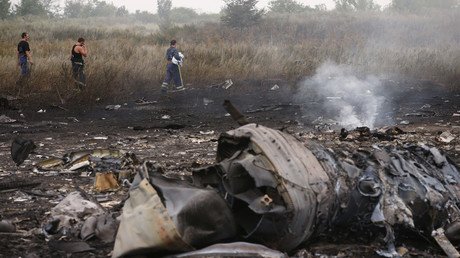‘Incompetent & biased’: Former air defense chief refutes Bellingcat ‘Russian Buk in Ukraine’ report

Comparing photos on social media with no knowledge of military practices is no way to carry out a serious investigation, the former commander of Russia’s air defense told RT, as he exposed inconsistencies and mistakes in a fresh Bellingcat report on MH17.
READ MORE: Official letter on MH17 investigation by top Russian aviation official Oleg Storchevoy
British citizen-journalist outfit Bellingcat released an “investigative” report on May 4 that claims to shed light on the missile system allegedly responsible for downing Malaysia Airlines Flight MH17 over eastern Ukraine in 2014.
The group searched for open-source images of military vehicles known to have been operating in eastern Ukraine on the day of the tragedy and claims to have identified a specific Buk air defense system that is said to have been seen near Donetsk. It alleges that the same Buk had been spotted at a Russian military base in Kursk earlier.
Retired Major General Mikhail Krusha, who was in charge of air defense in the Russian military from 2008 to 2010, ridiculed the very approach taken by Bellingcat, saying that “carrying out a comparative analysis based on photos from a five-year period in a piece of equipment’s life is as unprofessional as it is ridiculous.”
“Anything can happen during this period. Each combat vehicle undergoes seasonal maintenance at least twice a year, as well as other maintenance work and upgrades. Some models can simply be disposed of during this period,” Krusha told RT.
The authors of the report claimed to have identified a specific Buk with the number 332 on its side, which, according to photos on social media, was seen in eastern Ukraine and earlier on a Russian military base in Kursk. Bellingcat, however, seemingly fails to understand what the three-digit number stands for.
“Such a three-digit identification system for military equipment exists in nearly all of the armies of former-Soviet states, including Ukraine’s,” Krusha said.
The three digits indicate the vehicle’s affiliation to a certain anti-aircraft missile division (3), the number of batteries in this division (3), and the number given to the self-propelled mount within the battery (2), he explained.
READ MORE: Using tragic MH17 crash as ‘political football’ is shameful
“This side number could have belonged to any self-propelled mount in any anti-aircraft missile unit, which has three divisions in it. As has repeatedly been stated, a Buk-M1 with such a side number could have been part of the 156th anti-aircraft missile regiment of the Ukrainian armed forces, which was previously stationed in the city of Donetsk and was in the area when the plane crash took place,” the retired major general said.
However, for some reason, the authors of the report ignored the possibility that the Buk involved could have been Ukraine’s.
The Bellingcat sleuths noticed that the side number of the Buk allegedly spotted and photographed in Donbass had the middle digit missing, alleging that it had been hidden in an attempt to mask the vehicle’s origin. Krusha said it would have been strange to conceal only one of the three identifying digits, as “those trying to hide something would have painted the whole three digits out.”
The retired general added that the attempts of the Bellingcat team to compare soot and oil stains on different pictures sounded like a “joke.”
READ MORE: 'MH17 report: No clear answers, means there’s no smoking gun evidence'
The semi-amateur investigators also noticed that the cables connecting the chassis to the rotating turret on the Buk system in question appeared to be arranged in a unique fashion.
Krusha stressed that the arrangement of cables cannot be viewed as a unique identifying feature of a certain Buk system.
“All production models have standard cables of the same length. They must be connected in a specific order – otherwise the ‘fire’ command won’t reach the intended surface-to-air missile. As for laying the cables, it can be performed in any order and often changed in the course of maintenance and repair work,” he explained.
The expert concluded by saying that the mistakes, inconsistences, and poor handling of facts found in the study indicate that Bellingcat’s researchers are “incompetent and biased” and their report is “just a cheap fake.”
The official Dutch investigation concluded that the MH17 flight was downed by a Buk missile, but has so far been unable to name the side responsible.
Kiev and its backers in the US and EU have consistently pointed the finger at the self-defense forces in Donetsk Region, while accusing Russia of supporting and supplying them.
Moscow has repeatedly denied those allegations and provided copious data to debunk the claims, but its evidence has been largely ignored by the West.
The statements, views and opinions expressed in this column are solely those of the author and do not necessarily represent those of RT.














